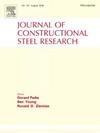An effective stress approach for the design of rectangular hollow section flexural members with slender elements
IF 4
2区 工程技术
Q1 CONSTRUCTION & BUILDING TECHNOLOGY
引用次数: 0
Abstract
An evaluation of North American and European design provisions for rectangular hollow section (RHS) flexural members with slender elements is performed. Seventy-three non-linear finite element models, covering practical ranges of width-to-thickness, height-to-thickness, and aspect ratio are developed, validated, and analyzed. The results demonstrate that current Class 3 or non-compact limit(s) in CSA S16, AISC 360, and EN 1990 are accurate; however, the effective width methods used in the current nominal strength expressions are inconsistent across different RHS orientations, and conservative (up to 11 %). To address this, a new effective stress approach using gross-section properties was explored. The new approach is shown to increase (up to 9 %) the accuracy and precision of nominal strength predictions when compared to the current approach(es), for all orientations, and still meet/exceed target reliability indices based on an approximate first-order reliability method analysis.
设计带有细长构件的矩形空心截面抗弯构件的有效应力法
本研究评估了北美和欧洲对带有细长构件的矩形空心截面 (RHS) 挠性构件的设计规定。开发、验证和分析了 73 个非线性有限元模型,涵盖了宽度-厚度、高度-厚度和长宽比的实际范围。结果表明,目前 CSA S16、AISC 360 和 EN 1990 中的 3 级或非紧凑型限制是准确的;但是,目前名义强度表达式中使用的有效宽度方法在不同的 RHS 方向上并不一致,而且比较保守(最多为 11%)。为了解决这个问题,我们探索了一种使用总截面特性的新有效应力方法。与目前的方法相比,新方法在所有方向上都能提高(高达 9%)名义强度预测的准确性和精确度,并且仍能达到/超过基于近似一阶可靠性方法分析的目标可靠性指数。
本文章由计算机程序翻译,如有差异,请以英文原文为准。
求助全文
约1分钟内获得全文
求助全文
来源期刊

Journal of Constructional Steel Research
工程技术-工程:土木
CiteScore
7.90
自引率
19.50%
发文量
550
审稿时长
46 days
期刊介绍:
The Journal of Constructional Steel Research provides an international forum for the presentation and discussion of the latest developments in structural steel research and their applications. It is aimed not only at researchers but also at those likely to be most affected by research results, i.e. designers and fabricators. Original papers of a high standard dealing with all aspects of steel research including theoretical and experimental research on elements, assemblages, connection and material properties are considered for publication.
 求助内容:
求助内容: 应助结果提醒方式:
应助结果提醒方式:


